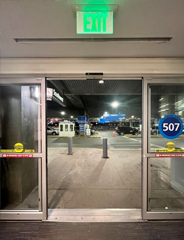Today’s commercial construction industry brings a surging demand for enhanced energy efficiency, sustainability, and optimized use of space. Additionally, it’s crucial to prioritize budget-friendly solutions.
A straightforward, economical and practical approach to meeting all these objectives is the implementation of an air curtain. Air Curtains have been gaining prominence since they were first approved as acceptable substitutes for vestibules by the ASHRAE/IES 90.1 standard in 2019. This complemented the 2015 IECC Code update, which contained a provision that enabled air curtains to be considered as alternatives to vestibules.
It’s a simple enough concept that can yield extraordinary results. First, let’s examine why air curtains, as vestibule exceptions, make for a significantly more practical storefront alternative.

Vestibule Exception Air Curtains are:
- Energy Efficient – Air Curtains reduce the load on heating, ventilation, and air conditioning (HVAC) systems by minimizing the exchange of conditioned air with the external environment. This results in lower energy consumption and operational costs. Ultimately, this results in energy savings through reduced HVAC bills.
- Sustainable – Air curtains are effective long-term solutions that can have payback periods of as little as a year. They require little maintenance and can be adjusted seasonally, to further maximize their effectiveness. By curbing energy consumption, businesses contribute to a reduction in greenhouse gas emissions, aligning with global sustainability goals.
- Space Savers – With retail space literally measured by the cost per square foot, every inch counts. By replacing a vestibule with an air curtain, valuable space is made available, which can be used to maximize sales.
- Cost Savers – Construction costs are high…and that doesn’t seem to be changing. Powered Aire’s Vestibule Exception air curtains can be ideal solutions to reduce/eliminate extra costs.
With these simple, yet extraordinary benefits, you’d think that every building would utilize. Let’s ask a few questions to first determine whether a Vestibule Exception Air Curtain can be used.
Does your application qualify for a vestibule exception? You don’t need a vestibule if:
- Your building is in climate zones 1 or 2
- The doors are not intended for use by the public (such as doors to mechanical or electrical equipment rooms or doors that are intended solely for employee use.)
- The doors open directly from a sleeping unit or dwelling unit.
- Doors that open directly from a space less than 3,000 square feet (298 m2) in area.
- Revolving doors are being used.
- The doors have an air curtain with a velocity of not less than 6.56 feet per second (2 m/s) at the floor that have been tested in accordance with ANSI/AMCA 220 and installed in accordance with manufacturer’s instructions. The door utilizes manual or automatic controls that operate the air curtain in conjunction with the opening and closing of the door. Air curtains and their controls shall comply with Section C408.2.3.
- Doors used primarily to facilitate vehicular movement or material handling and adjacent personnel doors
Three drawbacks of traditional vestibules
While traditional vestibules provide a buffer from the direct outdoors, they are often designed incorrectly and both sets of doors are open simultaneously, which defeats their purpose.
Three key issues with vestibules in new construction:
- They take up considerable, and critical, retail space.
- They utilize additional, and expensive, building resources.
- They require more time and labor during the buildout.
The Air Curtain Solution:
Air curtains operate by emitting a continuous stream of controlled air across the entrance, creating an invisible shield that acts as a thermal barrier. This barrier minimizes the exchange of indoor and outdoor air, preventing the influx of cold air in winter or hot air in summer. By doing so, air curtains effectively maintain a comfortable indoor temperature while simultaneously allowing for unrestricted movement of people and goods through the entrance.

Powered Aire offers three types of air curtains that have been tested in accordance with the ANSI/AMCA 220 standard and meet the criteria for use as an exception to the 2015 International Energy Conservation Code (IECC) vestibule requirement.
Types of Vestibule Exception Air Curtains
- EXPOSED AIR CURTAINS - The first consist of traditional, low profile air curtains. These architecturally focused air curtains are available in unheated or heated (electric, steam or hot water) and the low-profile units offer a higher degree of aesthetics to complement a building’s interior design.
- IN CEILING AIR CURTAINS - While hidden from site, in ceiling air curtains offer the same performance levels and meet the required standards for vestibule exception air curtains. They are, however, tucked away into the ceiling. These units are also available with heated and unheated options.
- RECESSED AIR CURTAINS - These air curtains are designed to be recess mounted above the ceiling. Depending on local code requirements, they can pull in air from the space above the ceiling or they can be ducted to the return air intake grill that sits in the ceiling.
In the pursuit of energy efficiency, Powered Aire’s Vestibule Exception Air Curtains are versatile and sustainable option for addressing the challenges posed by traditional vestibules. By seamlessly integrating into building design and operation, air curtains not only enhance climate control but also contribute to a more sustainable and environmentally conscious future.
